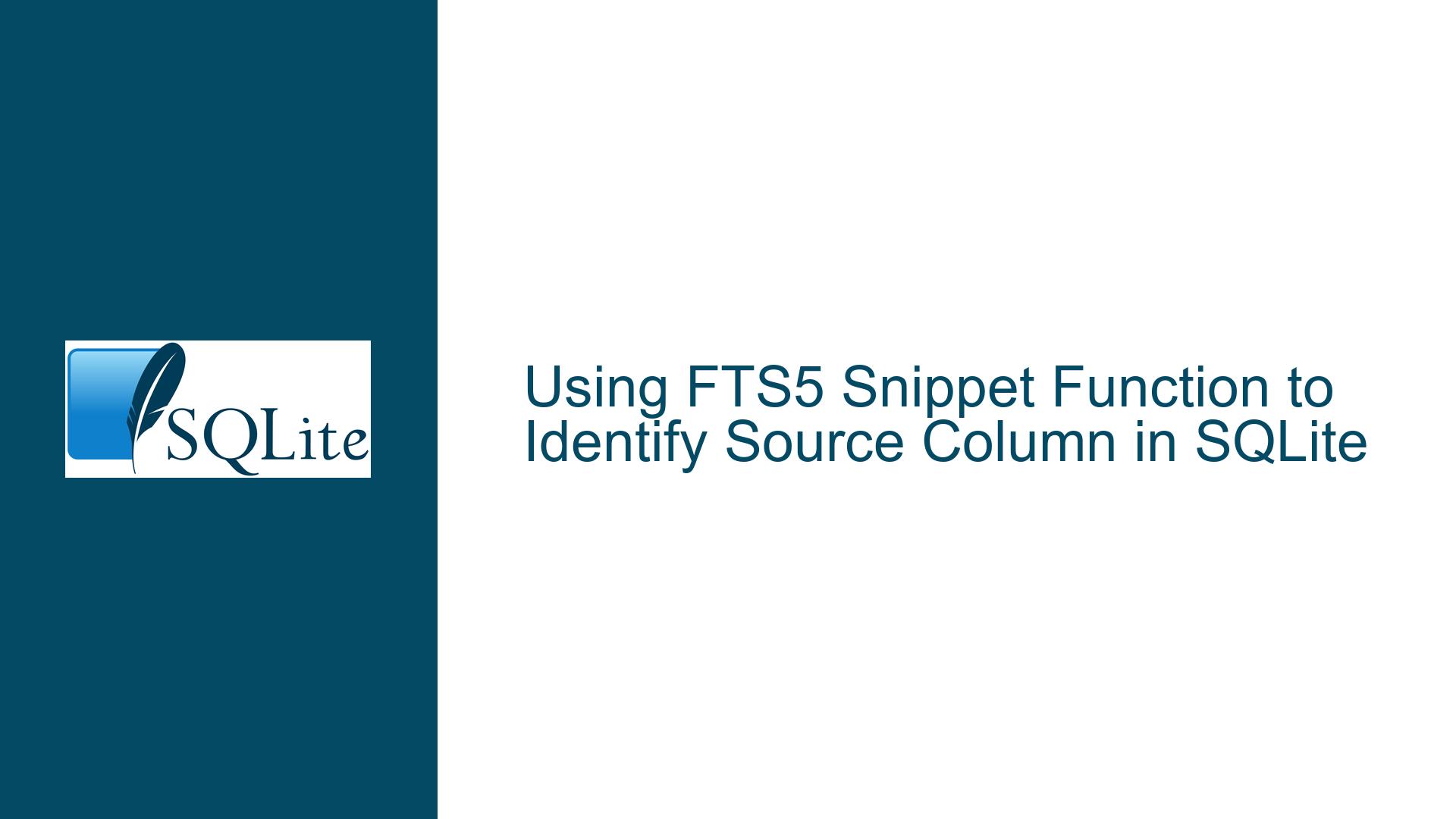Using FTS5 Snippet Function to Identify Source Column in SQLite
Issue Overview: Identifying the Source Column in FTS5 Snippet Results
When working with SQLite’s Full-Text Search version 5 (FTS5), the snippet function is a powerful tool for extracting contextual text snippets from search results. The function allows users to specify which column to extract snippets from, or it can automatically select a column by passing a negative value as the first parameter. However, a common challenge arises when users need to determine the specific column from which each snippet was extracted. This is particularly important in scenarios where columns have distinct semantic meanings, and knowing the source column can help refine the presentation or further processing of search results.
The core issue revolves around the limitation of the snippet function in FTS5: while it can generate snippets from multiple columns, it does not inherently provide metadata about the source column of each snippet. This limitation complicates workflows where column-specific semantics are critical. For example, if a user searches across columns like "title," "description," and "tags," knowing which column a snippet originated from can significantly enhance the relevance and usability of the search results.
The discussion highlights two primary approaches to address this limitation: a SQL-based workaround and a programmatic solution using SQLite’s C API. The SQL-based approach involves generating snippets for each column individually and then comparing these snippets to the automatically generated one. While this method is straightforward, it may not be efficient for tables with many columns due to performance concerns. The programmatic approach, on the other hand, involves extending SQLite’s functionality by creating a custom auxiliary function in C. This method offers greater flexibility and efficiency but requires advanced programming skills and a deeper understanding of SQLite’s internal APIs.
Possible Causes: Why FTS5 Snippet Function Lacks Column Metadata
The absence of column metadata in the FTS5 snippet function’s output can be attributed to several factors. First, the function is designed to prioritize simplicity and performance. By default, it focuses on extracting relevant text snippets without incurring the overhead of tracking additional metadata. This design choice aligns with SQLite’s philosophy of being a lightweight and efficient database engine.
Second, the snippet function’s automatic column selection mechanism is optimized for speed and resource efficiency. When a negative value is passed as the first parameter, the function dynamically selects the most relevant column based on the search query. While this approach enhances usability, it abstracts away the underlying column information, making it inaccessible to the user.
Third, SQLite’s FTS5 module is primarily intended for full-text search operations, and its auxiliary functions are designed to complement these operations rather than provide extensive metadata. The snippet function, in particular, is tailored for text extraction and formatting, not for detailed result analysis. As a result, users seeking column-specific information must rely on workarounds or custom extensions.
Finally, the lack of built-in support for column metadata in the snippet function reflects a broader trade-off between functionality and complexity. Adding such features would require significant changes to the FTS5 module, potentially impacting its performance and usability. For users with specific needs, the recommended approach is to extend SQLite’s functionality through custom code, as suggested in the discussion.
Troubleshooting Steps, Solutions & Fixes: Addressing the Column Identification Challenge
To address the challenge of identifying the source column in FTS5 snippet results, users can explore several approaches, ranging from SQL-based workarounds to advanced programmatic solutions. Each method has its advantages and limitations, and the choice depends on factors such as the number of columns, performance requirements, and technical expertise.
SQL-Based Workaround: Comparing Snippets Across Columns
The simplest approach involves generating snippets for each column individually and comparing them to the automatically generated snippet. This method leverages SQLite’s ability to execute multiple queries and perform string comparisons. Here’s a step-by-step breakdown of how to implement this solution:
Generate Automatic Snippet: Use the
snippetfunction with a negative value as the first parameter to generate a snippet from the most relevant column. For example:SELECT snippet(fts_table, -1, '[', ']', '...', 10) AS auto_snippet FROM fts_table WHERE fts_table MATCH 'search_query';Generate Column-Specific Snippets: Create snippets for each column individually. For example:
SELECT snippet(fts_table, 1, '[', ']', '...', 10) AS column1_snippet, snippet(fts_table, 2, '[', ']', '...', 10) AS column2_snippet FROM fts_table WHERE fts_table MATCH 'search_query';Compare Snippets: Compare the automatically generated snippet to the column-specific snippets to determine the source column. This can be done using a
CASEstatement or a series ofWHEREclauses. For example:SELECT CASE WHEN auto_snippet = column1_snippet THEN 'column1' WHEN auto_snippet = column2_snippet THEN 'column2' ELSE 'unknown' END AS source_column FROM (/* subquery combining the above snippets */);
While this approach is straightforward, it may not be efficient for tables with many columns, as it requires generating and comparing multiple snippets for each search result. Additionally, it assumes that the automatically generated snippet will exactly match one of the column-specific snippets, which may not always be the case due to formatting or truncation differences.
Programmatic Solution: Creating a Custom Auxiliary Function in C
For users with programming expertise, a more efficient and flexible solution involves creating a custom auxiliary function in C. This function can extend the snippet function to include column metadata in its output. Here’s a detailed guide to implementing this solution:
Set Up Development Environment: Ensure you have a working C development environment and access to SQLite’s source code. Download the SQLite source code from the official website or GitHub repository.
Understand the FTS5 API: Familiarize yourself with SQLite’s FTS5 API, particularly the
fts5_aux.cfile, which contains the implementation of the built-insnippetfunction. This file serves as a reference for creating custom auxiliary functions.Define the Custom Function: Create a new C function that extends the
snippetfunction to include column metadata. The function should accept the same parameters as the built-insnippetfunction but also return the source column information. For example:static void fts5_custom_snippet( const Fts5ExtensionApi *pApi, /* API offered by current FTS version */ Fts5Context *pFts, /* First arg to pass to pApi functions */ sqlite3_context *pCtx, /* Context for returning result/error */ int nVal, /* Number of values in apVal[] array */ sqlite3_value **apVal /* Array of trailing arguments */ ) { // Implementation goes here }Implement Column Detection Logic: Within the custom function, implement logic to detect the source column of each snippet. This may involve iterating through the columns, generating snippets, and comparing them to the automatically generated snippet.
Register the Custom Function: Register the custom function with SQLite using the
sqlite3_create_functionAPI. This makes the function available for use in SQL queries.Test the Custom Function: Execute SQL queries that use the custom function to verify its correctness and performance. Ensure that the function returns the expected column metadata without introducing significant overhead.
Deploy the Custom Function: Integrate the custom function into your application or database environment. This may involve compiling the function into a shared library or embedding it directly into your application’s codebase.
This approach offers greater flexibility and efficiency compared to the SQL-based workaround. However, it requires advanced programming skills and a deep understanding of SQLite’s internal APIs. Additionally, maintaining custom code can introduce complexity, especially when upgrading to newer versions of SQLite.
Alternative Approaches: Leveraging External Tools and Extensions
In addition to the above methods, users can explore alternative approaches to address the column identification challenge. These include:
Using External Full-Text Search Engines: If SQLite’s FTS5 module does not meet your needs, consider using an external full-text search engine like Elasticsearch or Apache Lucene. These engines offer advanced features, including detailed metadata and customizable search results.
Extending SQLite with Plugins: SQLite supports plugins that can extend its functionality. Users can develop or use existing plugins to enhance the FTS5 module’s capabilities, including adding column metadata to snippet results.
Preprocessing Data: Before performing full-text searches, preprocess the data to include column information in the text itself. For example, prefix each column’s content with a unique identifier. This allows the
snippetfunction to include column metadata in its output.Post-Processing Results: After generating snippets, post-process the results to infer the source column based on contextual clues or additional metadata. This approach requires careful design and may not be as accurate as other methods.
Each of these alternatives has its trade-offs, and the choice depends on your specific requirements and constraints. For example, using an external search engine may provide more advanced features but introduce additional complexity and resource requirements.
Best Practices for Optimizing FTS5 Performance
Regardless of the approach you choose, optimizing the performance of FTS5 queries is essential for maintaining a responsive and efficient search experience. Here are some best practices to consider:
Index Optimization: Ensure that your FTS5 indexes are optimized for your search queries. Use appropriate tokenizers and consider enabling additional features like prefix and suffix matching.
Query Optimization: Write efficient search queries that leverage FTS5’s capabilities. Avoid overly complex queries that may degrade performance.
Result Limitation: Limit the number of results returned by your queries to reduce processing overhead. Use
LIMITandOFFSETclauses to paginate results.Caching: Cache frequently accessed search results to reduce the load on your database. Implement caching at the application level or use SQLite’s built-in caching mechanisms.
Monitoring and Profiling: Regularly monitor and profile your FTS5 queries to identify performance bottlenecks. Use tools like SQLite’s
EXPLAIN QUERY PLANto analyze query execution.
By following these best practices, you can ensure that your FTS5 implementation remains efficient and scalable, even when dealing with large datasets and complex search requirements.
Conclusion
Identifying the source column in FTS5 snippet results is a common challenge that requires careful consideration of SQLite’s capabilities and limitations. While the built-in snippet function does not provide column metadata, users can address this limitation through SQL-based workarounds, custom auxiliary functions, or alternative approaches. Each method has its advantages and trade-offs, and the choice depends on factors such as performance requirements, technical expertise, and the complexity of your search use case.
By understanding the underlying causes of this limitation and exploring the available solutions, you can enhance the functionality and usability of your FTS5 implementation. Whether you opt for a simple SQL workaround or a more advanced programmatic solution, the key is to balance performance, flexibility, and maintainability to meet your specific needs.






